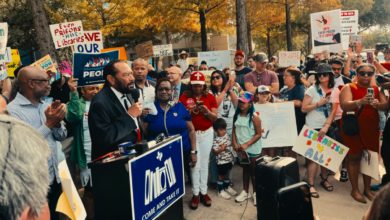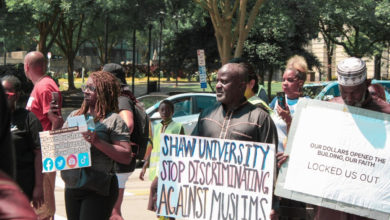On Dec. 14, striking Teaching Assistants won a key battle against the rehabilitation of a Confederate statue on the Chapel Hill Campus of the University of North Carolina. Their refusal to submit final grades was a key factor in the North Carolina Board of Governor’s decision to reject a proposal to put the symbol of white supremacy and slavery back on campus.
The war continues to rage at the Chapel Hill campus over the statue of a Confederate statue known as Silent Sam. For decades students have demanded that the monument to slavery and racism be removed from this public campus, and over the last few years the struggle has only intensified. Finally, in August, days after the first anniversary of anti-racist demonstrator Heather Heyer’s murder at the hands of a white supremacist in Charlottesville Va., students here in Chapel Hill took matters into their hands and toppled Silent Sam.
The administration, however, is fighting back. On Dec. 3, it asked the Board of Governors for $5.3 million to build a shrine that would house the bronze statue in perpetuity. Following the proposal, at least 79 outraged teaching assistants responded by withholding almost 2,200 grades in resistance. Even though faced with serious repercussion including threats of losing their positions and livelihood by the university administration, these brave strikers and other supporters marched on the site of the Dec. 14 Board of Governor’s meeting that would decide Sam’s fate. Ultimately, the Board rejected the administration’s proposal to bring back the statue out of “concern over cost.”
There is no doubt that the concern over the price tag for construction played a role for these traditional advocates of austerity. But the Board would never have rejected the proposal were it not for the action taken in felling Silent Sam and the subsequent TA strike putting pressure on the Board.
Statue represents ‘Lost Cause’ myth justifying Jim Crow, rise of Klan
Much of the corporate media coverage of the toppling of Silent Sam and related events fails to consider the historical context of the statue as a symbol of white supremacy in the South, as well as the current shifting of the social order in the state of North Carolina.
Today, that legacy, the myth of the “Lost Cause,” is alive and well, hidden by UNC administrators behind a veil of civility. Propagated by former Confederates and supported by white supremacist terrorist organizations, the “Lost Cause” ideology re-casts the Civil War as a noble crusade brought to heel by ne’er-do-wells intent on repressing Southern liberty and individual rights. The myth justifies the disenfranchisement of African-Americans and the establishment of the Jim Crow regime of racial separation and discrimination.
Erected in the early twentieth century, Silent Sam was a monument to these very ideals. During the dedication in 1915, North Carolina industrialist Julian Carr proudly claimed that it was the “courage and steadfastness” of young UNC students who fought in the Civil War that “saved the very life of the Anglo Saxon Race in the South.”
Academia’s ‘marketplace of ideas’ justifies racism, cutbacks
This myth justifying the Confederacy has taken on a new life since the 1970s, given cover by a campus-centered postmodernism which also legitimizes neoliberal cutbacks. Centrist administration technocrats who uphold this philosophy reject universal narratives like Marxism in favor of an extremely relativist view of truth. Without any unifying theory, they see ideas as disconnected from their material basis, and all equally viable. This “marketplace of ideas” view justifies giving a platform to white supremacists on college while disparaging those on the broad Left who seek to take away the racists’ soapbox.
Attempting to placate all parties to hold a non-existent center position, UNC- Chapel Hill Chancellor Carol Folts has tried to broker a compromise between the protesters that felled Silent Sam and their allies and the Board of Governors and sections of the public that want Silent Sam restored.
Folts acknowledged the troubled history of Silent Sam, and assured the public that the statue, toppled through mass struggle, would not be brought back to “the front door,” of the campus. At the same time, she assured those who wanted the statue restored that it would have a place on campus. She gave lip service to Sam’s connection to white supremacy, but in practice she backs restoring the statue and also retribution against key anti-racist activists like Maya Little. Folt’s convenient public sidestepping of responsibility under the guise of non-partisanship highlights the weaponization of the relative narrative by administrators.
More at stake than a statue
Months after Sam was torn down, why does his specter still loom over the UNC-Chapel Hill campus? This has never been an issue of just a statue. At stake is not just the fate of the broken bits of bronze, but the soul of the university system.
Looking at the demands of the graduate student protesters are fighting the extension of the horizon of the UNC system in a more reactionary manner.
The students are taking aim at the most draconian aspects of the Board of Trustees’ proposals, such as the $2.2 million-dollar budget allocation for the creation of special taskforce to police protest movements that echoes the FBI’s COINTELPRO project of the 1960s and 1970s.
The student movement is not just a reaction to the Board’s proposal. It proposes a better vision of the university through increasing wages for graduate student and other campus workers, along with improved benefits for both.
These bread and butter demands cut to the very heart of the structural problems that exist within the university system. The public university in North Carolina, like others across the United States, is facing the interlocked crises of funding and student debt.
Starting with the neoliberal turn of the 1970s, the university system, and many other segments of the public sector, adopted the view that schools should operate more like private enterprise. No longer would higher education be, as the North Carolina constitution guarantees, “extended to the people of the State free of expense.” Instead, it would be the personal responsibility of 18-year-old students to find a way to support themselves and acquire an education. This logic allowed state appropriations for education to shrink by almost 50 percent and for revenue from tuition to be go up at a similar rate between 1986 and 2017.
Broadside attacks on university workers
At the same time, like any business concerned with the bottom line, the university and its new administrative cadre sought as elastic of a labor pool as possible. In 1986, almost 73 percent of the university’s faculty were tenured, while another nearly 20 percent were on track for tenure. Only 38 percent were tenured and 13 percent on tenure track as of the fall of 2016. There were both political and economic reasons for this. Moving away from the tenure system toward adjunct labor has allowed the UNC to underpay its faculty and easily shed objectors to the status quo through the precarity brought on by little to no job security.
Speaking before the Board of Governors in the fall of 2016 as a product of the UNC system and a concerned historian, this reporter pointed to this state of affairs as going against the University’s foundational mandate outlined in the North Carolina Constitution. Rather than address my concerns directly with media present, the Board later posted a response on their website, which in true neoliberal fashion, said a lot and nothing at all. Claiming concern for affordability as their top priority, they pointed to a slight increase in appropriations that does not acknowledge long-term trends.
The struggle is just beginning
As the graduate student workers and organizers find themselves in the throes of a victory through an unprecedented public sector strike in a state where “right to work” is firmly entrenched, they now must prepare themselves to face the same body that will likely again try to compartmentalize all dissent by any means necessary.
While the current triumph represents an important moment, the struggle is just beginning. The Board has set a March deadline for a new proposal on Silent Sam that they will then evaluate.
Despite the uncertainty that hangs in the air, Joseph Karlik, Party for Socialism and Liberation member and organizer involved with the strike, stated that he hopes their example will “embolden and reinvigorate the labor movement here in the belly of the beast.” Further, he hopes the movement will “dispel any illusions that these institutions are anything more than irredeemable links in the chains of white supremacy and settler colonialism.”






